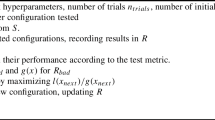Abstract
With the rise of edge computing and the Internet of Things (IoT), there is an increasing demand for models with low memory footprints. These models must be adaptable to embedded system applications, while being able to leverage the large quantities of data recorded in these systems to produce superior performance.
Automatic Neural Architecture Search (NAS) has been an active and successful area of research for a number of years. However, a significant proportion of effort has been aimed at finding architectures which are able to effectively extract and transform the information in image data. This has lead to search space design which is heavily influenced by the heuristics of image classifiers.
We review and incorporate the characteristics of successful time-series methods, while seeking to address traits of conventional NAS search-space design which may be detrimental to performance on time-series.
This paper provides an in-depth look at the effects of each of our design choices with an analysis of time-series network design spaces on two benchmark tasks: Human Activity Recognition (HAR) using the UniMib-SHAR dataset and Electroencephalography (EEG) data from the BCI Competition IV 2a dataset.
Guided by these design principles and the results of our experimental procedure, we produce a search space tailored specifically to time-series tasks. This achieves excellent performance while producing architectures with significantly fewer parameters than other deep learning approaches.
We provide results on a collection of datasets from the UEA Multivariate time-series Classification Archive and achieve comparable performance to both deep learning and state-of-the-art machine learning time-series classification methods, using a simple random search.
Access this chapter
Tax calculation will be finalised at checkout
Purchases are for personal use only
Similar content being viewed by others
References
Zoph, B., Vasudevan, V., Shlens, J., Le, Q.V.: Learning transferable architectures for scalable image recognition (2018). https://doi.org/10.48550/ARXIV.1707.07012. arXiv: 1707
Liu, H., Simonyan, K., Yang, Y.: DARTS: Differentiable architecture search. arXiv: 1806.09055 (2019)
Schrodi, S., Stoll, D., Ru, B., Brox, T., Hutter, F.: Towards discovering neural architectures from scratch, Rhea Sukthanker (2022)
Ismail Fawaz, H., Forestier, G., Weber, J., Idoumghar, L., Muller, P.-A.: Transfer learning for time series classification. In: 2018 IEEE International Conference on Big Data (Big Data), pp. 1367–1376 (2018). https://doi.org/10.1109/BigData.2018.8621990
Middlehurst, M., Large, J., Flynn, M., Lines, J., Bostrom, A., Bagnall, A.: Hive-cote 2.0:aA new meta ensemble for time series classification. Mach. Learn. 110(11-12), 3211–3243 (2021)
Dempster, A., Petitjean, F., Webb, G.I.: Rocket: exceptionally fast and accurate time series classification using random convolutional kernels. Data Mining Knowl. Dis. 34(5), 1454–1495 (2020)
Middlehurst, M., Large, J., Bagnall, A.: The canonical interval forest (cif) classifier for time series classification. In: 2020 IEEE International Conference on Big Data (Big Data), pp. 188–195 (2020). https://doi.org/10.1109/BigData50022.2020.9378424
Wang, Z., Yan, W., Oates, T.: Time series classification from scratch with deep neural networks: A strong baseline. In: 2017 International Joint Conference on Neural Networks (IJCNN), pp. 1578–1585 (2017). https://doi.org/10.1109/IJCNN.2017.7966039
Fawaz, H.I., Lucas, B., Forestier, G., et al.: InceptionTime: finding AlexNet for time series classification. Data Mining Knowl. Dis. 34(6), 1936–1962 (2020). https://doi.org/10.1007/s10618-020-00710-y.
Stanley, K.O., Miikkulainen, R.: Evolving neural networks through augmenting topologies. Evol. Comput. 10(2), 99–127 (2002). https://doi.org/10.1162/106365602320169811
Miikkulainen, R., Liang, J., Meyerson, E., et al.: Evolving Deep Neural Networks (2017)
Micucci, D., Mobilio, M., Napoletano, P.: Unimib shar: a dataset for human activity recognition using acceleration data from smartphones. Appli. Sci. 7(10) (2017). https://doi.org/10.3390/app7101101. https://www.mdpi.com/2076-3417/7/10/1101, ISSN: 2076–3417
Brunner, C., Leeb, R., Müller-Putz, G., Schlögl, A., Pfurtscheller, G.: Bci competition 2008–graz data set a. In: Institute for Knowledge Discovery (Laboratory of Brain-Computer Interfaces), Graz University of Technology, vol. 16, pp. 1–6 (2008)
Radosavovic, I., Kosaraju, R.P., Girshick, R., He, K., Dollar, P.: Designing network design spaces. In: Proceedings of the IEEE/CVF Conference on Computer Vision and Pattern Recognition (CVPR) (2020)
Radosavovic, I., Johnson, J., Xie, S., Lo, W.-Y., Dollár, P.: On network design spaces for visual recognition (2019). arXiv: 1905.13214
Liu, Z., Mao, H., Wu, C.-Y., Feichtenhofer, C., Darrell, T., Xie, S.: A convnet for the 2020s. In: Proceedings of the IEEE/CVF Conference on Computer Vision and Pattern Recognition, pp. 11 976–11 986 (2022)
Oord, A. v. d., Dieleman, S., Zen, H., et al.: Wavenet: A generative model for raw audio, arXiv preprint arXiv:1609.03499 (2016)
Bergstra, J., Bengio, Y.: Random search for hyper-parameter optimization. J. Mach. Learn. Res. 13(1), 281–305 (2012)
Gao, W., Zhang, L., Teng, Q., He, J., Hao, W.: Danhar: dual attention network for multimodal human activity recognition using wearable sensors. Appl. Soft Comput. 111, 107728 (2021)
Mukherjee, D., Mondal, R., Singh, P.K., Sarkar, R., Bhattacharjee, D.: Ensemconvnet: a deep learning approach for human activity recognition using smartphone sensors for healthcare applications. Multimedia Tools Appli. 79, 31663–31690 (2020)
Al-qaness, M.A.A., Dahou, A., Elaziz, M.A., Helmi, A.M.: Multiresatt: multilevel residual network with attention for human activity recognition using wearable sensors. IEEE Trans. Industrial Inform. 19(1), 144–152 (2023). https://doi.org/10.1109/TII.2022.3165
Helmi, A.M., Al-qaness, M.A., Dahou, A., Abd Elaziz, M.: Human activity recognition using marine predators algorithm with deep learning. Future Generation Comput. Syst. 142, 340–350 (2023)
Teng, Q., Wang, K., Zhang, L., He, J.: The layer-wise training convolutional neural networks using local loss for sensor-based human activity recognition. IEEE Sens. J. 20(13), 7265–7274 (2020)
Ruiz, A.P., Flynn, M., Large, J., Middlehurst, M., Bagnall, A.: “The great multivariate time series classification bake off: a review and experimental evaluation of recent algorithmic advances. Data Mining Knowl. Dis. 35(2), 401–449 (2021)
Author information
Authors and Affiliations
Corresponding author
Editor information
Editors and Affiliations
Rights and permissions
Copyright information
© 2023 The Author(s), under exclusive license to Springer Nature Switzerland AG
About this paper
Cite this paper
MacKinnon, C., Atkinson, R. (2023). Designing a New Search Space for Multivariate Time-Series Neural Architecture Search. In: Ifrim, G., et al. Advanced Analytics and Learning on Temporal Data. AALTD 2023. Lecture Notes in Computer Science(), vol 14343. Springer, Cham. https://doi.org/10.1007/978-3-031-49896-1_13
Download citation
DOI: https://doi.org/10.1007/978-3-031-49896-1_13
Published:
Publisher Name: Springer, Cham
Print ISBN: 978-3-031-49895-4
Online ISBN: 978-3-031-49896-1
eBook Packages: Computer ScienceComputer Science (R0)





